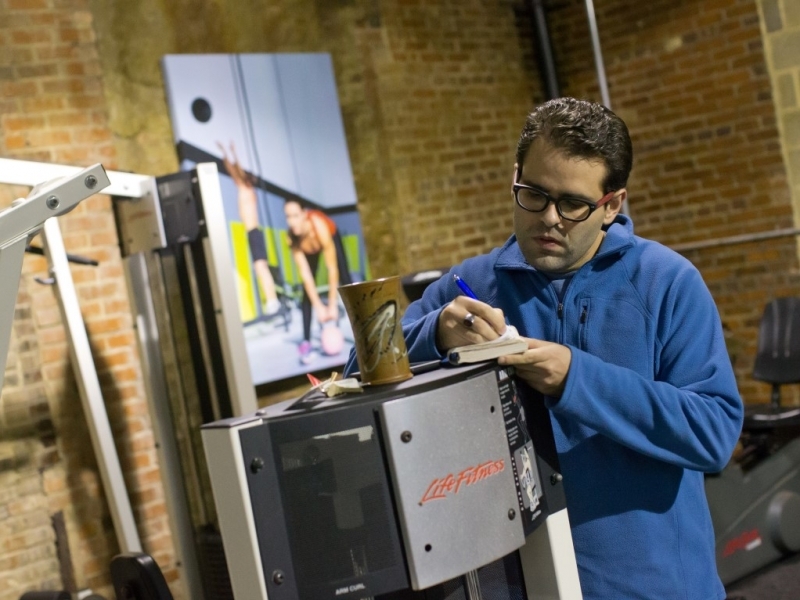Social Media as Memory
Photography By:
Ryan S. Brandenberg

Throughout his recovery from a severe brain injury, Thomas Dixon, EDU '14, used sophisticated assistive technologies such as Twitter to allow him to manage—and largely mask—a severe disability resulting in memory loss.
Thomas Dixon, EDU ’14, thumbs his iPhone at a Philadelphia sandwich shop. Like many thirtysomethings—like many anysomethings—he scrolls through texts, checks appointments and tweets a few times during lunch.
It’s the way Dixon relies on these technologies that differs markedly from most people who use them. When Dixon wants to recall what he did yesterday, he picks up his phone and consults his Twitter feed.
There, in a private account with nearly 21,000 tweets, is a log of moments in Dixon’s life since December 2010, a month after he was hit by a car while running and suffered a traumatic brain injury that led to memory loss.
Throughout his recovery, Dixon’s sophisticated use of assistive technologies such as Twitter has allowed him to manage—and largely mask—a severe disability. Since his accident, he has earned a graduate degree in educational psychology from Temple, qualified for Mensa and spent each New Year’s Eve exploring a different country.
And a year after the accident, he ran a half marathon in a custom shirt. “My life was in question,” stated the front. “This is my answer,” read the back.
“I live at a time where I have my emails in my pocket. I have my texts. I have so many strategies that we’re all already using,” Dixon, 30, says. “Even though I have this severe disability, it almost sounds silly to say ‘severe,’ because look at how well I’m living. All the technology we use, and my ability to apply these strategies, mitigates the severity of it. It really cuts it short.”
At the time of the accident, Dixon was a research coordinator at the Children’s Hospital of Philadelphia heading to medical school to pursue his dream of becoming a psychiatrist. Then, on Nov. 22, 2010, he went out for a run he doesn’t remember.
During the accident, Dixon suffered a traumatic axonal injury, one of the worst types of brain injuries. The head trauma was so powerful that his axons—the communication pathways in brain cells that allow us to perform activities—were stretched or sheared, leading to cell death.
In Dixon’s case, the brain trauma didn’t dramatically impair his cognitive abilities—he’s bright and talented. But two types of memory were affected: delayed memory, or the ability to retain information over periods of time, and episodic memory, or the ability to remember context from experiences.
That’s where Twitter comes in. Dixon is constantly tweeting episodes of his life (“Lifted weights as I had breakfast and now about to shower, shaving during”; “I just finished hearing the most recent Savage Lovecast, having some herbal tea, and ate a pear”). He also invites guest commentary from friends and acquaintances, to whom he hands over his Twitter account. These tweets provide records of interactions, and some include direct messages to Dixon. “Thank you for a great talk,” stated a recent tweet. “I will be checking out meetup.com website.”
“This could feel insular or isolated,” Dixon says of managing his memory loss. “Handing my phone to them and letting them write something in my digital memory includes them in it.”
Madeline DiPasquale is a clinical neuropsychologist who treated Dixon at MossRehab’s Drucker Brain Injury Center. She says Dixon helps manage his memory loss by combining his intellectual ability and thirst for new experiences with an extraordinary comfort with technology.
“Tom’s premorbid skills were about being inquisitive, seeking out knowledge, learning how to do things and challenging himself,” DiPasquale says. “He brought all of those skills to his recovery after the injury.”
Dixon’s mother, Tina Dixon, says she always had confidence in him, despite the circumstances he faced.
“He’s a survivor,” she says. “You just go and do what you’ve got to do. That’s the way he always was.”